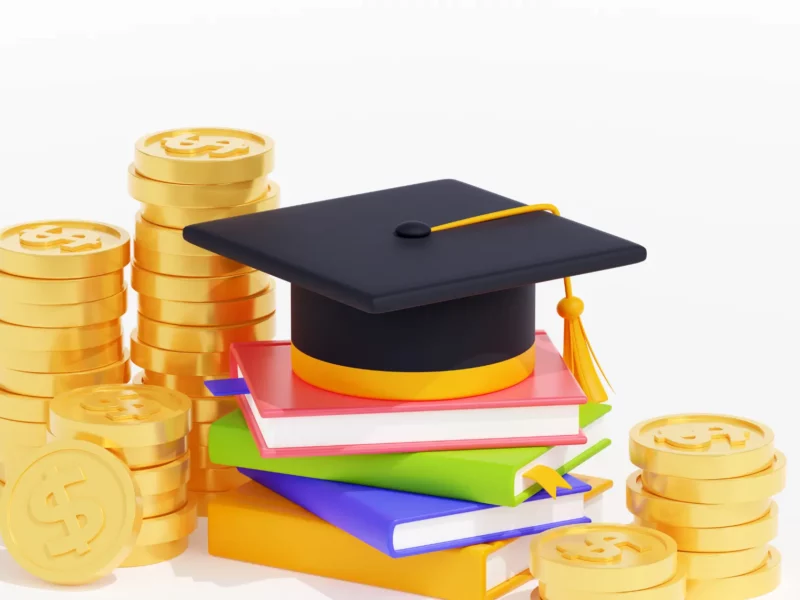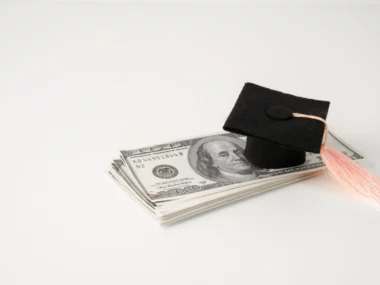Table of Contents
At this point, it is no longer a secret that getting a post-secondary education costs an arm and a leg.
While some students may have parents who are rich enough to afford tuition fees and other education-related expenses, others either don’t have parents to cater for their education costs or have parents who can’t afford it.
Therefore, it is understandable that many students, both local and international, are flocking towards education loans as their saving grace.
However, before pulling the trigger for this type of loan, it is important to know all there is to know about it, so they don’t leave school uninformed about the way to manage their debt.
Journey with us as we carry out a thorough examination of education loans and all you need to know about them.
What is an Education Loan?
This is the type of loan that a student borrows to cater for higher education costs, including tuition and other school-related expenses such as room and board, transportation, textbooks, and so on.
When applying for an education loan, it is advisable to take only what you need, as borrowing in excess will only add to the debt that you will have to repay in the future.
Although, most lenders usually place a limit on the amount that a borrower can take each year. This amount is usually based on the cost of attendance at the school the borrower is attending.
When you borrow a student loan, you are not required to pay it back until after getting your degree or certificate.
How To Apply For An Education Loan
- To apply for a student loan, the first thing you need to do is to fill out a Free Application for Federal Student Aid (FAFSA) to find out of you are eligible for a federal student loan. You can fill out the FAFSA form online at the office of the Federal Student Aid website.
- Using the information that you provided in your FAFSA, the financial aid offices at your college will decide how much financial aid to provide for you.
- If you do not qualify for a federal student loan or you qualified but the money isn’t enough to cover all your educational expenses, you can apply to get a loan from a private lender, which can be either a bank, a credit union, or an online lender. Here, instead of filling out a FAFSA, you fill out the financial institution’s form.
4. The final step is to pick a school and find out how much you’ll need to attend it.
See more on how to apply
Types of Student Loans
There are two major types of student loans namely:
- Federal student loans; and
- Private student loans.
Student Loans: All You Need To Know About Federal Student Loans
Federal student loans are loans granted by the US government. This is the most common type of student loan due to the numerous advantages that it presents compared to private student loans. Federal student loans usually have low-interest rates and flexible repayment plans. To apply for this loan, you will have to fill out a FAFSA.
Types of Federal Student Loans
There are four types of Federal student loans namely:
- Direct subsidized loans.
- Direct unsubsidized loans.
- Direct PLUS loans.
- Direct consolidation loans.
Direct Subsidized Loans
These are loans granted to undergraduate students according to their financial need. The interest on this loan is usually subsidized by the government while you are in school and you’ll only have to start making payments six months after you finish school.
Direct Unsubsidized Loans
These are loans granted to both graduates and undergraduates, regardless of their financial need. Unlike Direct subsidized loans, the student is responsible for paying the whole interest on the loan both while they are in school and after graduation.
Direct PLUS Loans
These are a type of federal student loan granted to graduates and parents of undergraduate students, regardless of their financial need. Part of the features that make this type of loan different from other types of federal student loans is that it can be used to cover some education costs that are not covered by other financial aid that a student may have. You are responsible for paying the whole interest on the loan.
Direct Consolidation Loans
This type of federal loan is taken to combine numerous federal loans that a student may have borrowed in the past into a single loan with a fixed interest rate. This makes it easy for students to repay their loans, as instead of making multiple payments monthly, the student just has to make one payment.
Repaying Federal Loans
When it comes to repaying federal student loans, there are several payment options available, including:
- Standard Repayment Plans: This is when you are given the option of making monthly payments, for 10 years.
- Graduated Repayment Plans: When using this option, you start by making a low payment which increases as time goes on. The period of payment is still under 10 years.
- Extended Repayment Plans: This repayment option stretches the payment window from 10 years to 25 years for borrowers with over $30,000 in debt. The payments can either be standard or graduated.
- Income-Based Repayment Plans: This repayment option lets you make payments according to a particular percentage of your earnings.
- Income-Contingent Repayment Plans: This option lets you make payments based on 20% of your leftover income after you have settled your expenses.
Private Student Loans
These are student loans gotten from private lenders such as banks, credit unions, and other financial institutions. The money gotten here can be used for a wide range of school expenses such as tuition, books, transportation, and other related expenses. To get these loans, you will need to have a good credit history, and if you don’t, you might need a co-signer.
The interest rates here are usually higher compared to federal loans and the repayment plans also differ. Also, unlike federal student loans that give you the grace of suspending repayment until six months after graduation, private lenders expect you to begin repaying your debt while you’re still in school.
One of the upsides of this type of student loan is that the amount you are allowed to borrow is higher compared to federal loans.
Why You Should Consider Applying For A Federal Loan Instead Of A Private Loan
1. Federal student loans offer low, fixed interest rates.
2. Their payment plans are usually flexible.
3. You don’t always need a credit check to get one.
4. The interest on some federal loans is subsidized by the government.
5. Students have the grace of suspending repayment until six months after graduation.
6. Borrowers of federal loans can qualify for loan forgiveness programs.
Health Professions Student Loans
Some student loans are specifically designed for students studying certain areas of medicine, including optometry, nursing, medicine, and so on. Each loan has its own requirements and loan package.
Differences Between A Federal Student Loan And A Private Student Loan
- Federal loans are considered as a first option while private loans are usually taken when students need more money to cover the expenses that the federal loan didn’t cover.
- Federal student loans are gotten from the government while private loans are gotten from private lenders such as banks.
- Some federal loans don’t require good credit while all private loans usually do.
- Federal loans offer low interest rates while the interest rates on private loans are usually high.
- The interest rates on federal loans are usually fixed while the interest rates on private loans are either fixed or variable.
- Some federal loans require students to demonstrate financial need while private loans don’t require such.
- The interest on some federal loans is subsidized while private loans don’t offer this benefit.
- Federal loans give the grace of suspending repayment until six months after graduation while private loans don’t allow such.
- Federal loans offer loan forgiveness programs while private loans don’t.
- Compared to private loans, federal loans offer flexible repayment options.
Some Possible Scenarios If You Are Unable To Repay Your Loan
- Student Loan Forgiveness: One of the possible scenarios that can unfold if you are not able to repay your loan is for the loan to get forgiven. It is important to note that not everyone qualifies for loan forgiveness as there are certain requirements that students need to meet before they can be eligible.
- Default: Another possible scenario if a student fails to repay their loan is the default. It happens if they continuously fail to make payments.
- Deferment: If you’re not able to repay your loan, you may be granted a deferment. This means you won’t have to make payments for now and you probably won’t have to pay interest. However, not everyone qualifies for it.
- Forbearance: Similar to deferment, this is when you are allowed to hold off on making payments for a while, except that if you are granted a forbearance, you will have to pay the interest that will continue to accumulate on the loan.
Education Loans Forgiveness
Education Loans forgiveness is when a lender decides to forgo a part or the whole of a person’s education loan. This is a fantastic option, especially for people who are struggling with making their loan payments.
However, this option isn’t usually available for everyone, due to the eligibility requirements that come with them.
It is also important to note that only Federal Education Loans have this kind of program, Private lenders don’t offer it. The only help that private lenders render is the refinancing option, which we will talk about later on.
Types of Education Loans Forgiveness
- One-time student loan debt relief: Loans that qualify for debt relief include William D. Ford Federal Direct Loan (Direct Loan) Program loans, Federal Family Education Loan (FFEL) Program loans held by ED, Federal Perkins Loan Program loans held by ED, and Defaulted loans.
- Public Service Loan Forgiveness (PSLF): This type of loan forgiveness program forgives federal student loans after one has made 120 qualifying payments while working for a qualifying public service employer. Current and former public service employees are some of the people who are eligible for this program.
- Teacher Loan Forgiveness: If you are an educator who has been employed in a school or an educational service agency for five straight years, and have loans that you’re not able to repay, try applying for this program.
- Income-driven repayment forgiveness: This type of forgiveness program sets your monthly payments according to what you earn and the size of your family. This means that your monthly payments could be as small as $0, and the rest of your monthly payments could be forgiven after making them for at least 20 years.
Student Loan Refinancing
This is when a borrower applies for a new loan to settle their existing student loans. Similar to federal loan consolidation, refinancing is used to combine your current student loans into a single monthly payment, which might come with a lower interest rate.
If you don’t qualify for federal education loan forgiveness, you can always use this option to make things easier for yourself. This option works for both federal and private loans.
How To Qualify For Student Loan Refinancing
To qualify for student loan refinancing, the lender, whether private or federal, will typically check your:
- Credit score.
- Job (A stable source of income).
- Your graduation status.
- Loan amount.
- Debt-to-income ratio.
How To Apply For A Student Loan Refinancing
After deciding that student loan refinancing is the best option for you, here is the step-by-step process on how to go about it.
1. Check your credit.
2. Find the best loan rates.
3. Pick a loan that is suitable for you.
4. Complete a loan application.
In Conclusion
Student loans have always been a great help to both local and international students who are unable to cater for their educational expenses and there are different types that you can apply for. However, it is important to understand how these loans work so you don’t end up making the wrong move. We hope our deep take on Student Loans: All you need to know helps you make the right decision.





